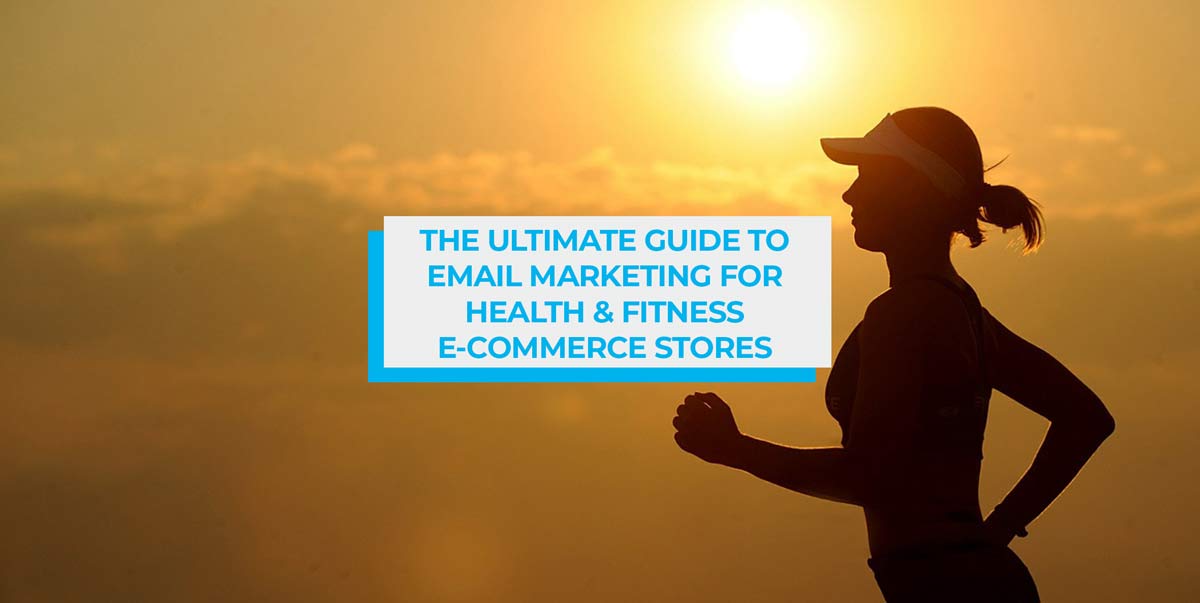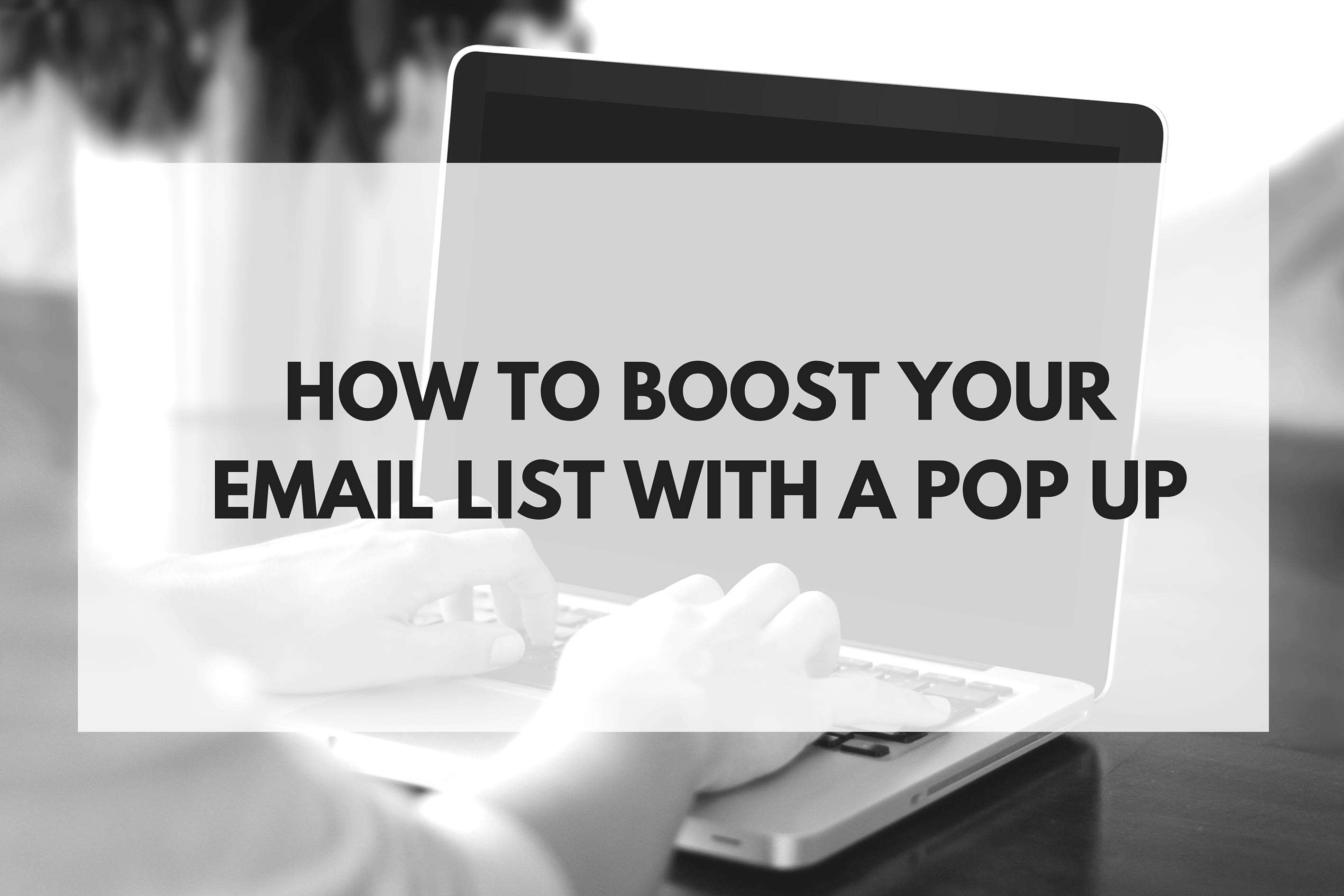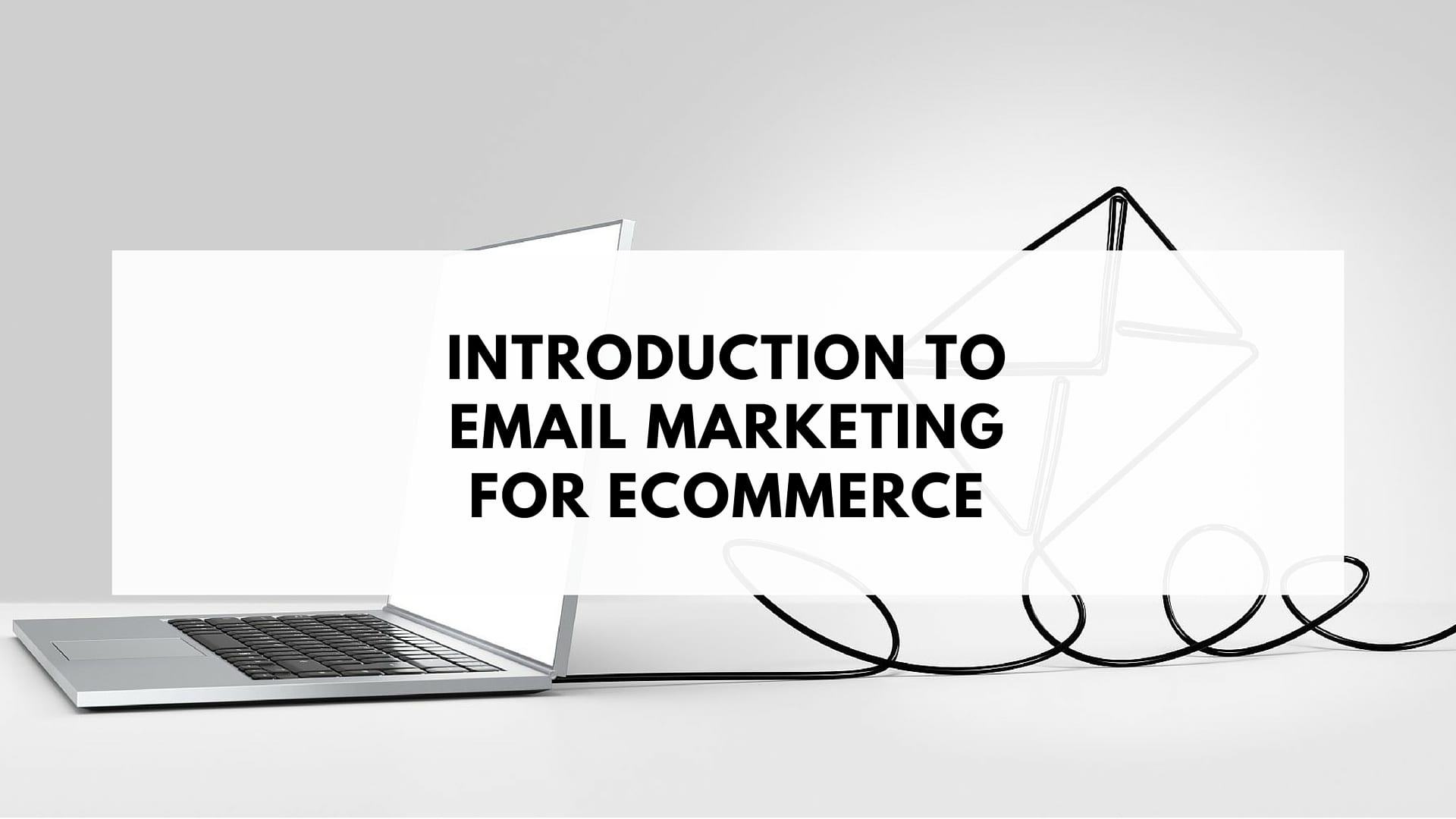SmartrMail is all about making gainz.
Whether that means I’m personally benching 405lbs for reps or our email marketing tool is helping businesses grow their customer list and revenue, it’s all about making gainz.
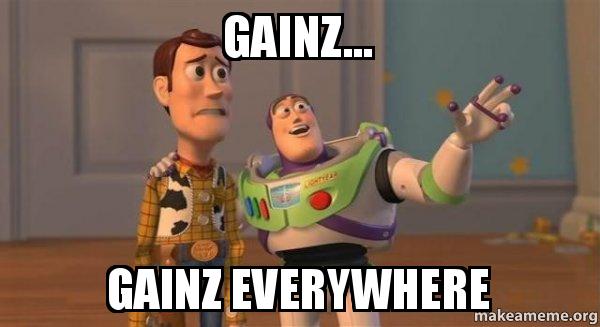
If you want to make gainz where it really matters (I’m talking about your business bank account, not your chest and biceps), then this is the only email marketing guide you’ll ever need to read.
In the next 4.5 minutes, I will cover every single type of email you should be sending, and provide you with real life examples using health and fitness e-commerce stores.
At the end of this article, you’ll learn:
- why lifetime value (LTV) and customer acquisition cost (CAC) will make or break your health and fitness store,
- why email marketing is your business’ cash cow,
- how to find the average time between your customers’ repeat orders, and
- seven automated emails every health and fitness store needs to have.
Let’s get shredded!
Note: I cannot bench 405lbs for reps. Or even 1 rep for that matter…
Health and fitness profit is all about LTV and CAC
Health and fitness isn’t a hobby – it’s a lifestyle choice.
But you already know that.
To build muscle, lose fat, improve endurance, increase strength, or [insert any health or fitness related goal], you have to continually put in the effort to reap the rewards.
Most health and fitness related products are consumable within a short time frame.
Protein powders, vitamin pills, creatine and fish oils all need to be reordered. Even clothing gets worn out eventually.
As a health and fitness e-commerce business, you’re not going to make massive profits from one-off sales; you’re going to make it from customers re-ordering over a period of time.
That’s where LTV and CAC come in.
Customer lifetime value (LTV) – This is the amount a person spends during their lifetime as a customer with your business.
Customer acquisition cost (CAC) – This is the amount it costs you to acquire a new customer through marketing.
For example, if it costs you $50 in marketing to acquire a new customer, and the average customer spends $200 (net after expenses) before they stop buying from you, you have made a profit of $150.
This is a 3:1 ratio (LTV/CAC) and should be the first target for your business. If your numbers are below that, you’re missing out on revenue.
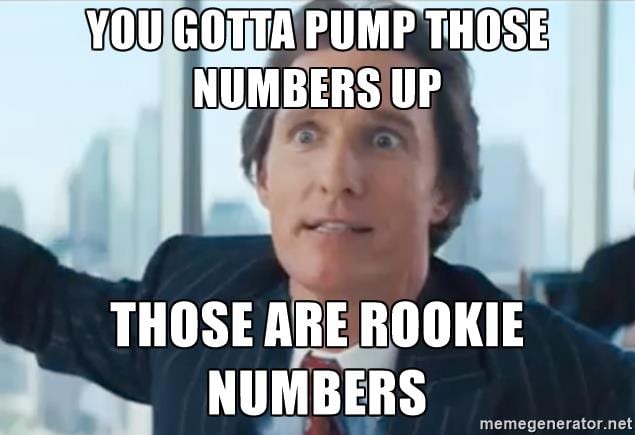
You need to know your LTV and CAC for three key reasons:
Scale – Once you know your CAC and LTV, you can begin to start scaling marketing campaigns to grow your business faster.
If you know a certain advert is generating a low CAC, you can allocate it more of your marketing budget and cut off campaigns that produce a high or unprofitable CAC.
If you have ran ads in the past and were unable to identify whether they were generating a profit or not, it’s probably because you didn’t know your LTV.
False flags – If you spent $100 on a Facebook ad that generated one sale for $120, then after expenses and profit margins you’ll be in the red and consider the campaign a failure.
However, a month later that customer reorders for another $120 and again for the following two months for similar amounts.
What was actually a very profitable campaign has been shut down because your customer’s LTV wasn’t taken into account.
The bulk of any health and fitness store’s revenue is made on repeat orders that happen over a longer period of time.
Growth – The fastest way to grow your business is to get current customers to spend more money. Existing customers are three times more likely to buy than new customers.
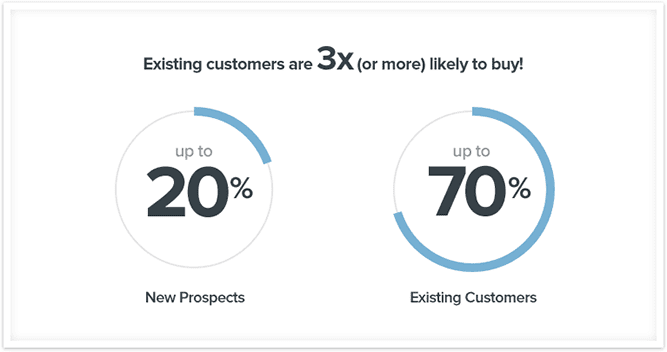
The easiest way to get them to spend more with your business is to offer them great products and a good experience.
It’s really that simple.
If you have great products and can offer customers a good experience, the only thing you need to do is to remind them every so often to order or try your new products.
And that’s what I’m about to show you now: examples of welcome emails, cross-sells, educational emails, and more from health and fitness businesses that have a strong online presence.
Each email type I’ll talk about can be fully automated through SmartrMail, meaning you only have to create the email once and it will be sent based on your customers’ behavior.
Check out our free Health & Fitness templates today!
? Install SmartrMail and use our free Health & Fitness templates ?
1. Welcome email
Let’s start from the top – your welcome email.
You need a welcome email.
The welcome email receives more opens than any other automated email you send and is the quickest way to turn a prospect into a customer.
They just signed up to your mailing list, so your brand is fresh in their mind; you need to strike when the iron is hot.
There are many angles you can take with the welcome email. Below, I will show you three examples.
Optimum Nutrition use their welcome email to get subscribers to follow their social media channels.
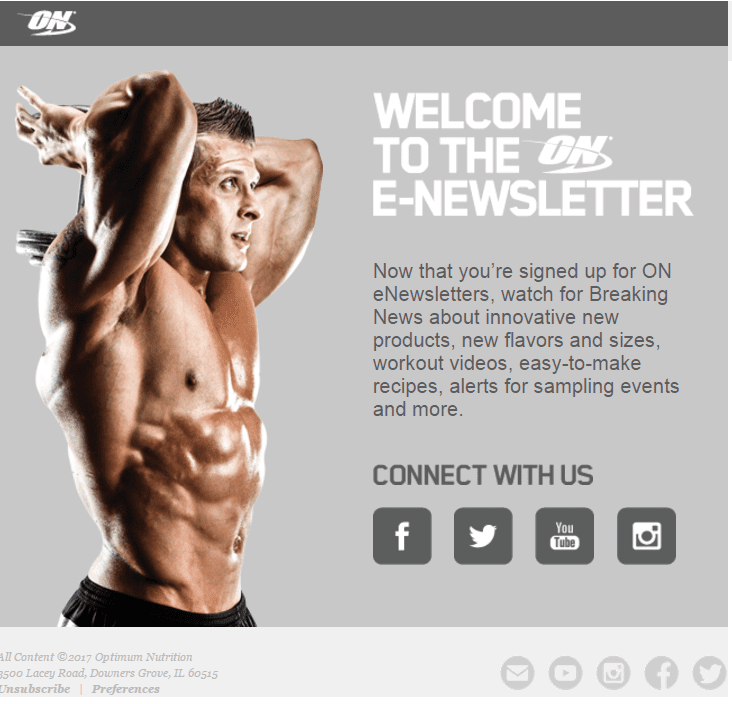
I don’t like this simply because a quick review of Optimum Nutrition’s social media account reveals that their last YouTube upload was over three months ago (at the time of writing this article), and their average engagement on Twitter is very low compared to their follower count.
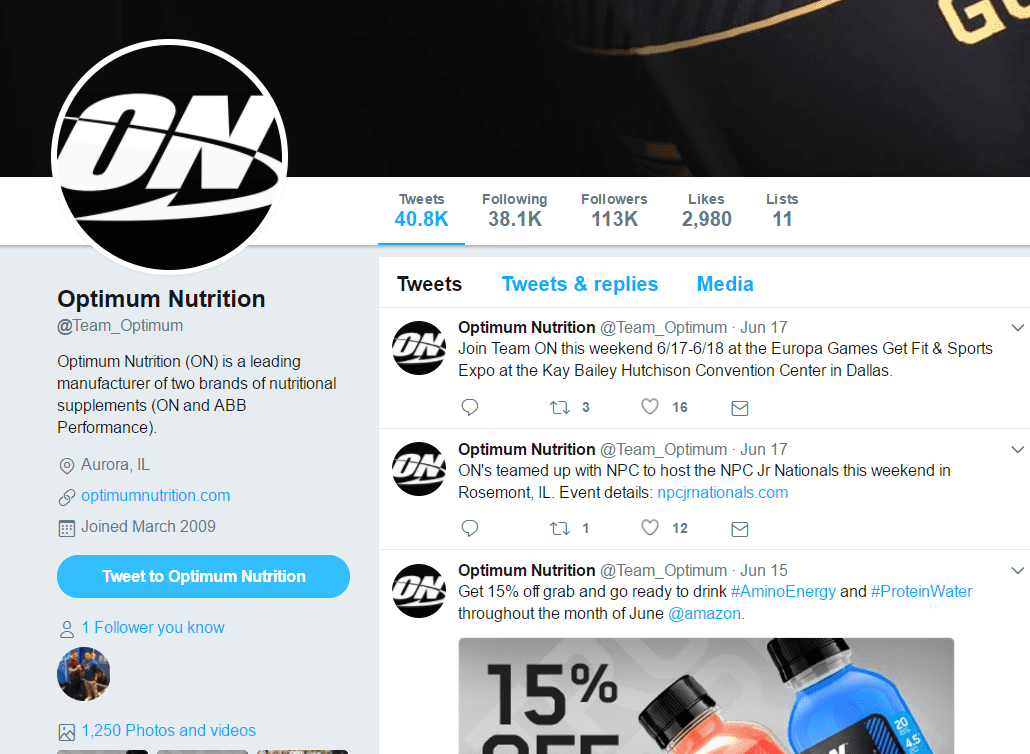
To me, this is a wasted opportunity to educate new sign-ups and sell.
If Optimum Nutrition were crushing on Twitter and posting frequent YouTube content then sure, I wouldn’t be mad.
But they aren’t, and they are losing revenue.
Email atrophy.
Next up is Myprotein, who introduce new sign-ups to their brand with a call to action to their bestsellers, clothing, and educational content such as recipes.
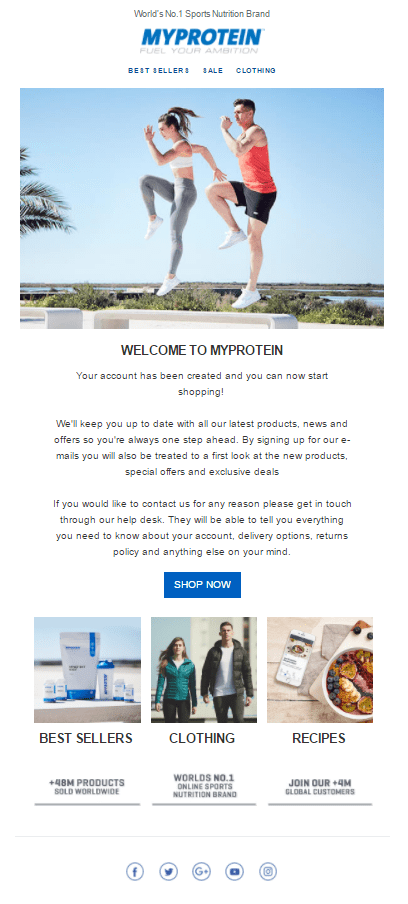
I like this welcome email a lot better, because they pre-frame sign-ups; by letting them know that they will be receiving more emails in the future, their sign-ups are subconsciously ready for future messages. They also offer three distinct links to their bestsellers, clothing, and recipes.
If you offer a varied range of products (supplements, clothing, and gym equipment), and use opt-in forms on all of your pages, then having more than one call to action is fine to showcase your whole range, since you won’t know which products the prospect is interested in.
Last up is Huel who use the welcome email to incentivize prospects to order their products by offering them a free t-shirt and shaker with their first order.
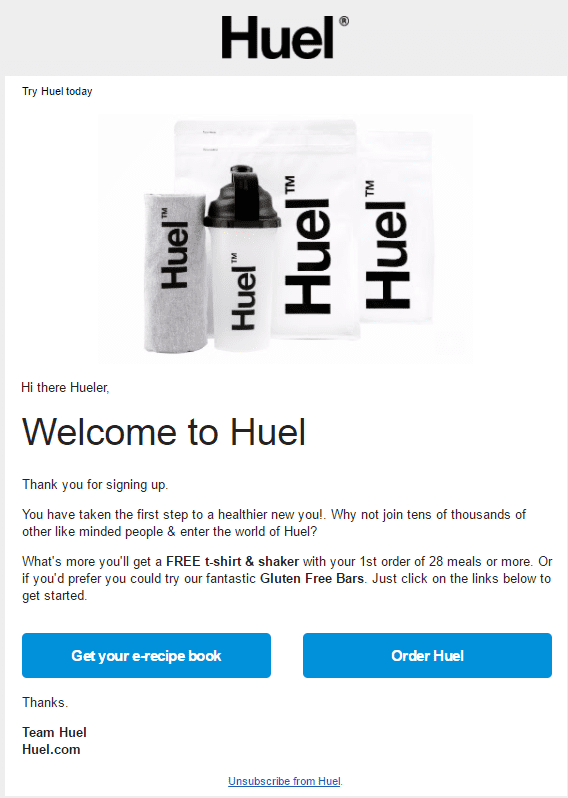
Prospects can view their free eBook (educational and branding) or order their products (sales).
Their welcome email doesn’t stop there. If you do not order right away, the next day they send the second part of their welcome email campaign that informs you about the nine flavors they stock and remind you that you can still claim your free t-shirt and shake bottle.
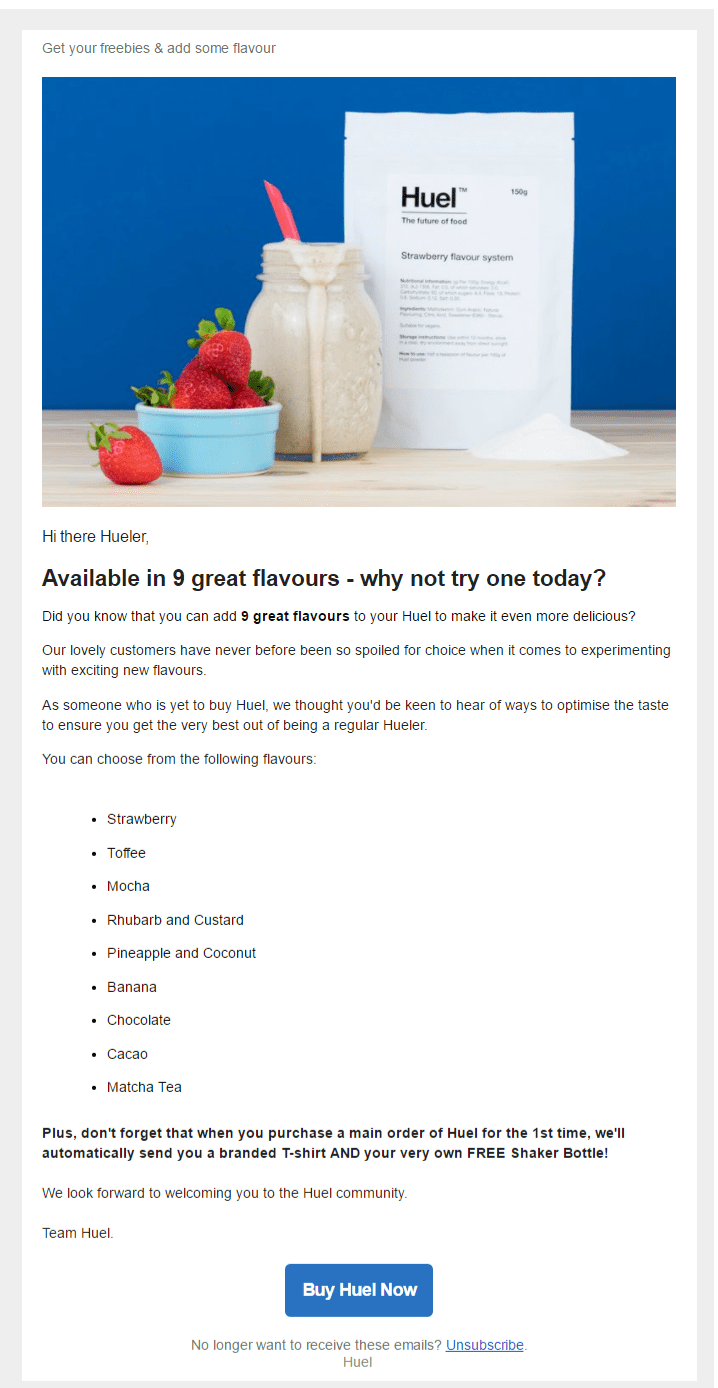
And they email again the following day if you still haven’t ordered.
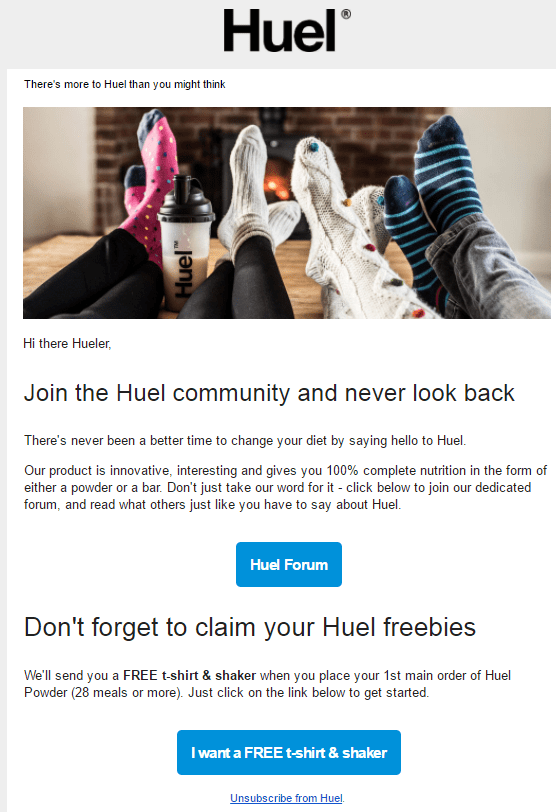
They actually send seven emails in seven days if you don’t order.
I typically don’t advocate having a welcome email series be that long, but for the health and fitness niche I’ll make an exception. A lot of people are on the fence about whether to join the gym, eat healthy, or get back in shape and they’ll need to be nudged a few times.
My only gripe with Huel’s welcome series is that the first six emails were pitch heavy, whereas the seventh email was a little more educational and persuasive.

They should lead with the email above in their first or second welcome email, because it reveals the products’ unique selling points. Then they should pitch.
You’ll notice that all three branded welcome emails have a common feature: a call to action.
Optimum Nutrition wants to generate more social media followers, whereas My Protein and Huel ask customers to make an order or consume their free content.
Your welcome email needs to have a clear call to action. I personally recommend offering customers a discount off their first order, as I find this helps push them off the fence and into paying customers. However, you can opt to educate them about your product, ask them to follow you on social media, or read a few of your blog posts.
To learn more, check out our guide on welcome emails here.
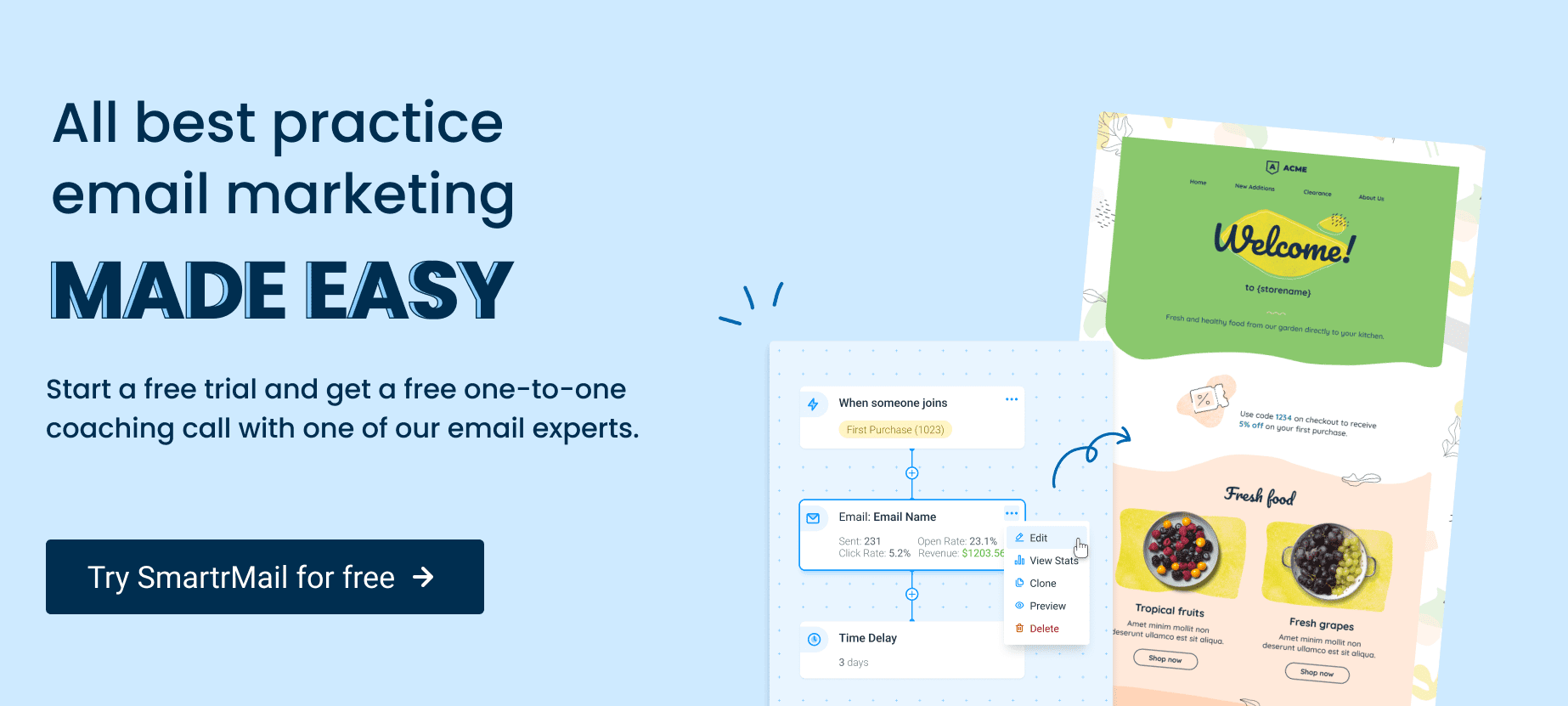
2. The cross-sell
The health and fitness niche is arguably one of the best industries to cross-sell to your customers.
For example, if a customer purchases a pre-workout supplement, then you might want to cross-sell an intra- or post-workout shake to them.
If a customer only purchases from a specific part of your store, you could send an email asking them to try other items in your store.
Paleo Robbie is a food delivery service that cooks meals each morning for their customers and offers an online grocery service where they deliver produce.
They offer distinct services.
In the email below, they are cross-selling to their Meal Plan customers by letting them know about their online grocery service.
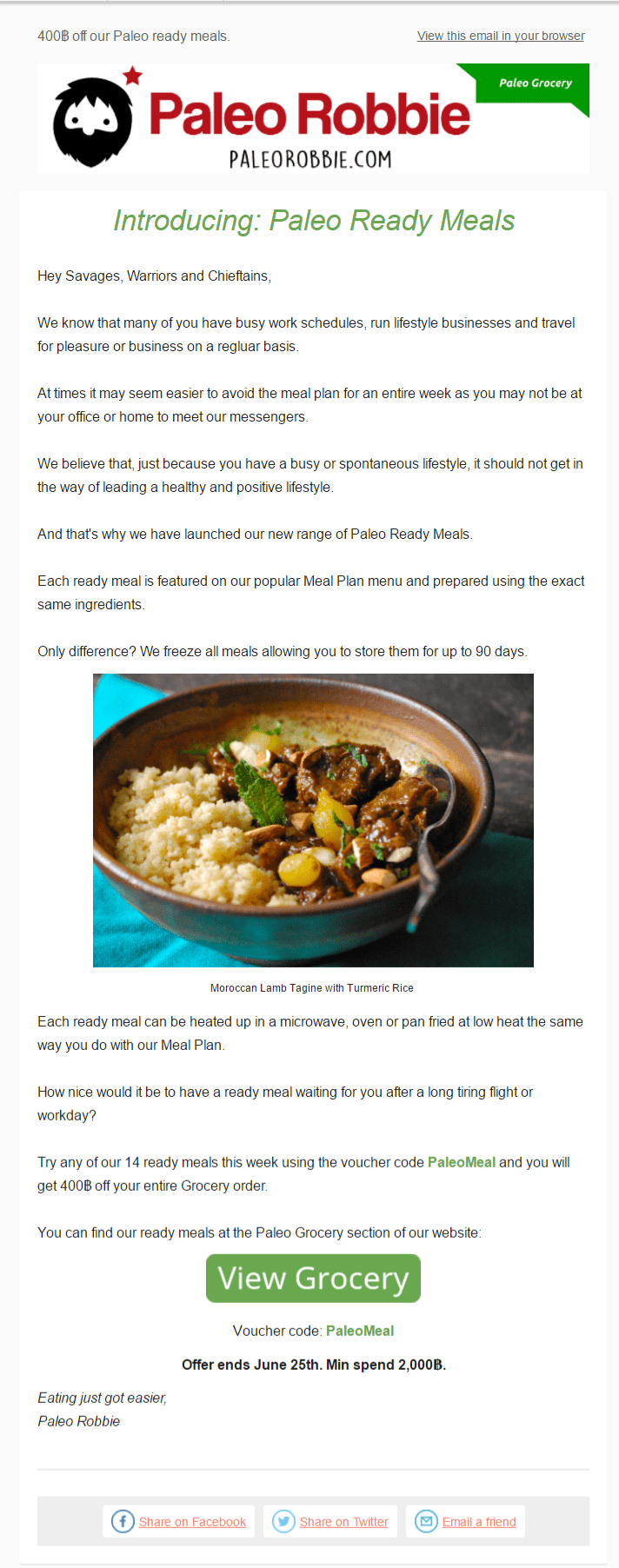
This email works amazingly well because the item they are promoting (frozen meals) is similar to their customers’ current order. Meal plan customers are familiar with the product and now have the option to keep frozen meals in their freezer on demand.
People who use meal delivery services are usually time-poor or don’t like to cook, so cross-selling them with frozen meals, that just need to be heated up, is much better idea than giving them a free uncooked steak with their next order.
When setting up your cross-sells, don’t be afraid to start the email with a problem your customer faces (like the email above) and then provide a solution (your product).
For example, if you’re cross-selling a weight gaining product, you might want to touch on pain points such as customers being too full and not being able to consume more calories, or not having the time to cook large meals.
If you’re cross-selling creatine, then list the benefits of increased endurance for cardio or being able to push out a few more reps.
To learn more, check out our guide on cross-sell emails here.
Sign-up to our newsletter and receive a free eBook with hidden Email Marketing Tips
3. Abandoned Cart
Your abandoned cart email is probably going to be the most profitable automated email that you send.
Reports estimate that around 65% of shopping carts are abandoned online, with the main reasons being high shipping costs, the buyer being not ready to buy, or a high product price.

Your abandon cart email should address at least one of the three pain points shoppers face.
Purity Products do this by offering customers 30% off their first order and free shipping if the prospect ends up ordering.
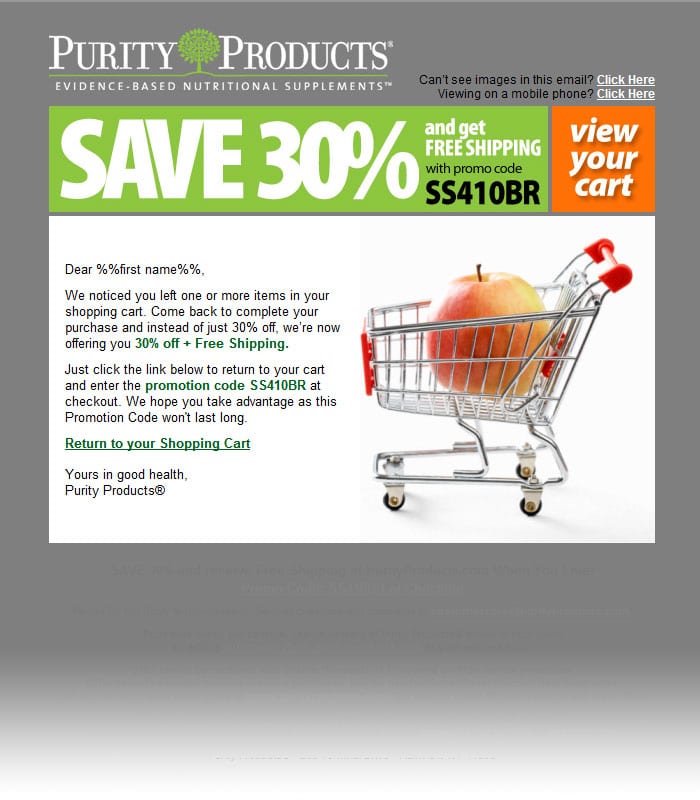
With 30% off their first order and free shipping, there’s a good chance that Purity Products are going to be in the red or at best breakeven if the customer uses their voucher.
This insane discount is part of a bigger strategy to acquire customers and use email marketing to get them to repeat order and increase their LTV and overall profits. If you currently have a very low re-order rate, I recommend you do not use this type of discount.
If you want to quickly acquire new customers, and in the short term can take a financial loss which won’t hurt your business, then give it a try.
Vitacost take a similar approach, but offer a smaller discount to get their customers to complete the checkout process, which is what I’d suggest doing when getting started with these types of emails.
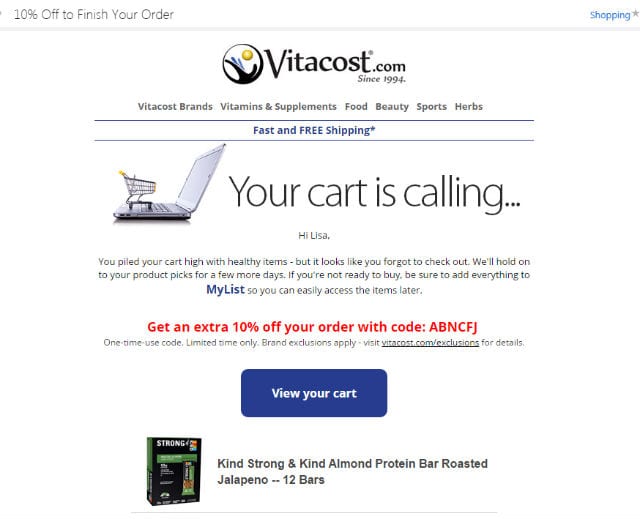
Sometimes, your product or shipping costs won’t be the issue and the prospect was just busy and got distracted.
GrazeShop don’t offer any special promotion or voucher code in their abandon cart email aside from their standard free delivery for items over £10. They just let the customer know that their order is saved if they wish to complete the checkout process.
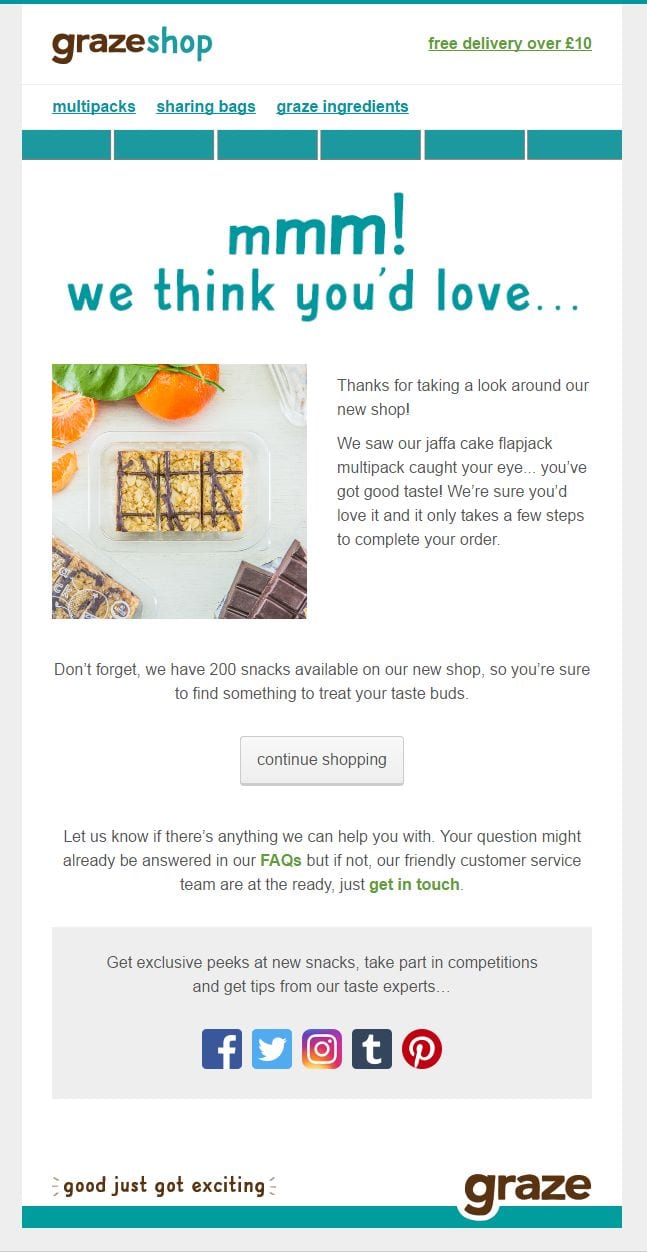
All three brands use different offers and messaging to seal the deal. My advice would be to create two abandoned cart emails – one with a small discount of 10% or free delivery, and another that emphasizes your product’s USP without an offer.
See which one generates more customers and go with that one.
To learn more, check out our guide on abandoned cart emails here.
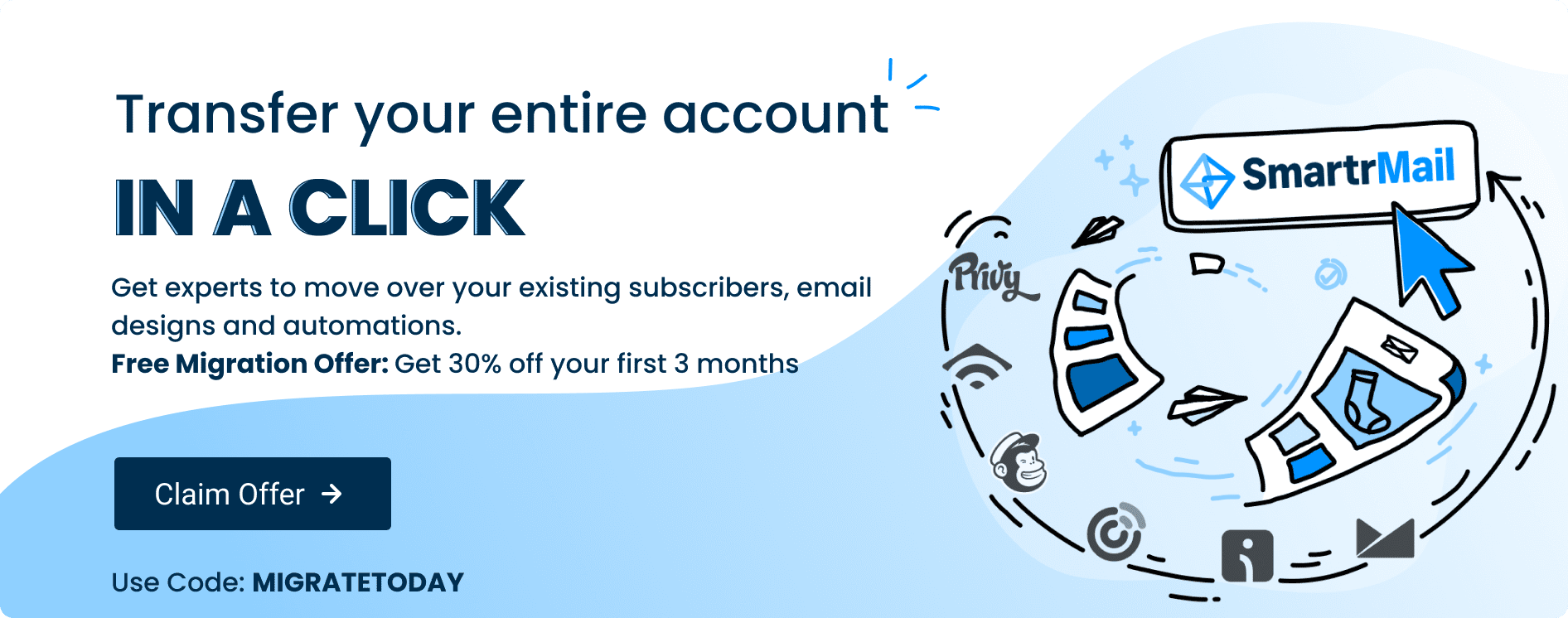
4. Educational emails
A big part of increasing your LTV is to educate your customers on how various products you sell can improve their health or training.
The primary objective of educational emails is to provide your subscriber with free value based around your niche. The secondary objective is extra sales.
For example, if your health store is focused around vegan health products, send your customers a link to an article on your blog that discusses the differences between soy and plant-based protein powders, or vegan recipes for muscle building.
Ideally, the content you create should relate to one of your products as this will provide the subscriber with more information about an item or category.
Thrive Market do this well by discussing the benefits of various items that they also sell in their store.

Notice how their subject lines for articles are bordering on click-bait but are still compelling enough to click.
Nobody is going to click an article titled:
Glucosamine for Hip Dysplasia & Arthritis Case Study
But they will click an article titled:
4 Ways Glucosamine Can Help Get Rid of Joint Pains
Don’t make your educational emails too complex or deep. While you may have a deep and complex understanding of every product or item you sell, most of your customers won’t, and you’ll need to talk to them in plain English.
The only thing I don’t like with Thrive Market’s email is that it doesn’t seem to be targeted at a specific audience, as they go from foods to boost happiness to skip mapping.
To really hit home with your educational messages, segment your list.
For example, a typical health and fitness e-commerce store will probably have the following segments:
- Lose weight
- Build muscle
- Get fit
Right away, we have three categories for blog topics. Segment your list based on order history and put them in the appropriate categories.
You can also sell-ucate (sell + educate) by talking about your product’s unique selling points.
Care/of, who sell various vitamin and health tablets, let customers know how much they save, how Care/of can make their life easier, and where their products come from.

Paleo Robbie’s grocery focuses on providing produce that is free of GMOs, hormones, and industrial farming. They sent out the following email to every customer who has ordered red meat from their grocery, letting them know what makes Paleo Robbie different.

5. Refill emails
A refill email is used to get your customers to re-order an item that they have fully consumed or are about to finish.
The below example shows a refill email from Rockin’ Wellness sent to a customer who may be about to run out of their Wellness Shake:
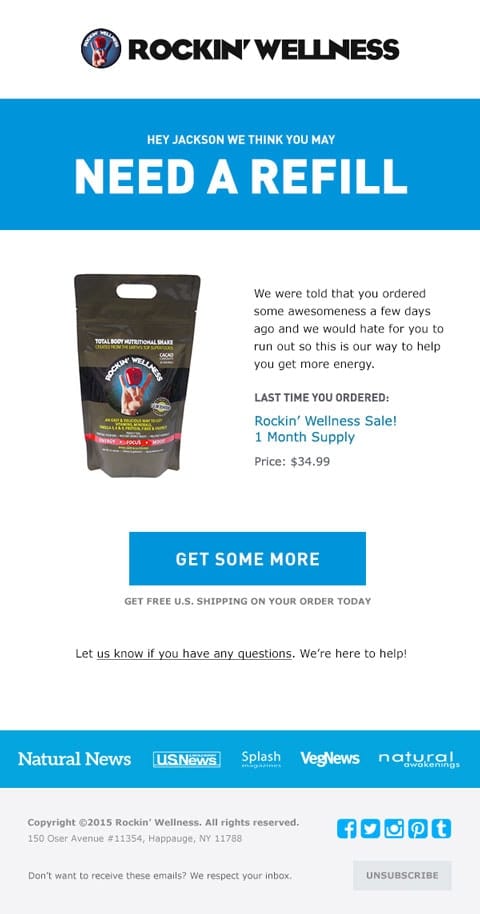
The success of refill emails is all about timing.
Ideally, you want to send a refill email about 7-9 days before the customer has consumed your product.
If you overshoot the date or time the refill email too close to completion, there’s a good chance they will have already reordered (perhaps from a competitor).
How do you know when they will run out of your product?
Check your internal data for your top products and find the average re-order rate.
If your bestselling 2kg protein powder is ordered once every 42 days on average, then on day 34 (eight days before they finish) send a refill email to customers recommending them to re-order as they’ll soon run out of the product.
You need to find the refill time of each set of products individually, as 1kg of creatine will require a longer refill time than 30 one-a-day fish oil tablets.
For products that are consumed in shorter time frames (seven days or less), I suggest timing your refill email a day or two before they run out. I would be very annoyed if I bought a seven-day supply of protein bars and the day after my order, I was sent a refill email.
Whatever you do, don’t sleep on refill emails.
When it comes to food and supplements, customers love to try new brands and flavors, which means their next top up order may be with a competitor.
For this reason, A/B test your refill emails by showing more than one brand for the item the customer bought last time. This allows them to try something new while still shopping at your store.
To learn more about refill emails, check out our guide on replenishment emails here.

6. Win-back campaigns
If you’re in the health and fitness niche, you know that people get lazy, stop working out, and give up on their fitness goals.
When they do that, they’ll also stop ordering from your store.

It doesn’t matter what you do, you’ll always end up having inactive customers on your email list who need to be shaken back into life.
The easiest way to do this, and what I suggest doing first, is to offer your customers – yes, you guessed it – some type of discount or voucher to order. Blue Apron do this in their emails:
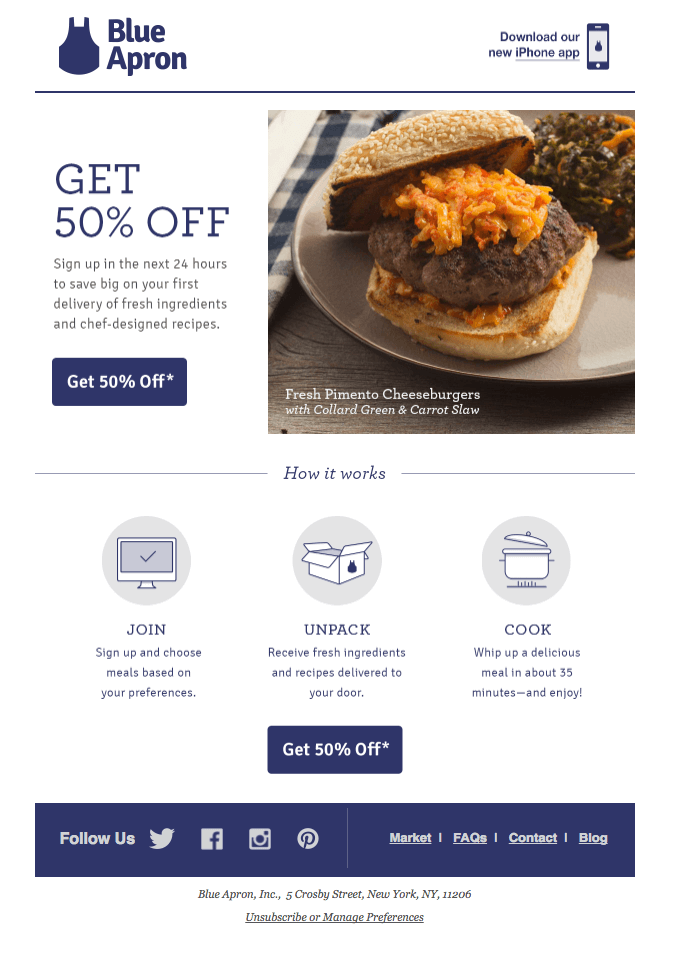
If you don’t like to give away discounts or vouchers too often, then consider emailing inactive customers with the changes you’ve made to your product range since their last purchase.
Blue Apron have a second win-back email that informs inactive customers that they have added more recipes and that customers can curate their own menu.
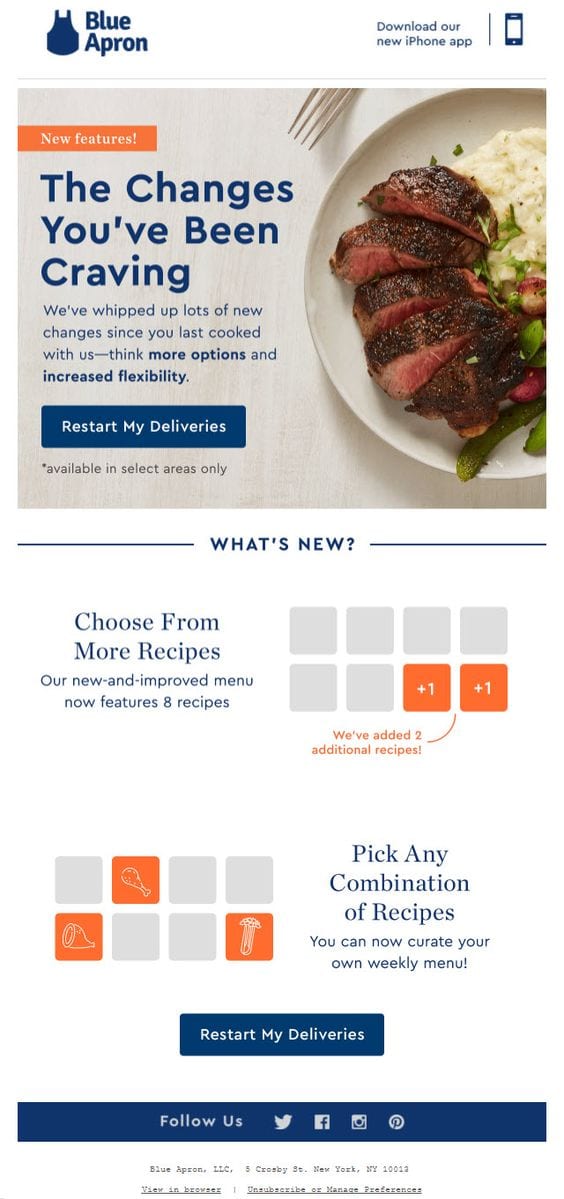
Reactivating old customers around New Year’s Day isn’t that hard because that’s the time when half the world decides that they are going to get back into shape (new year, new me). You can usually send them a tailored email about how they can get started using your products.
But what about March, April, and May when the bulk of people give up on their goals and you notice a slump in sales?
An out-of-the-box approach is to set up a ‘get fit’ campaign to persuade old customers to get back into shape for the holidays based on their location.
For example, if your customer base is solely in Australia, then their summer is between December 1st and February 28th.
A month before summer, you could send out a free eBook of recipes, home workouts, or exercises that inactive customers can do to get back into shape, along with items in your store that can help them reach their goals.
I usually run this type of campaign for around 30 days or less, so it’s not too overwhelming for inactive customers to get started. Launch the campaign just before a summer holiday period, as that will provide them with a greater incentive than if you were to do it right before winter.
To learn more, check out our guide on win-back emails here.
7. Review emails
Product reviews are a big deal.
Recent studies reveal that consumers look at online reviews when deciding whether to take action.
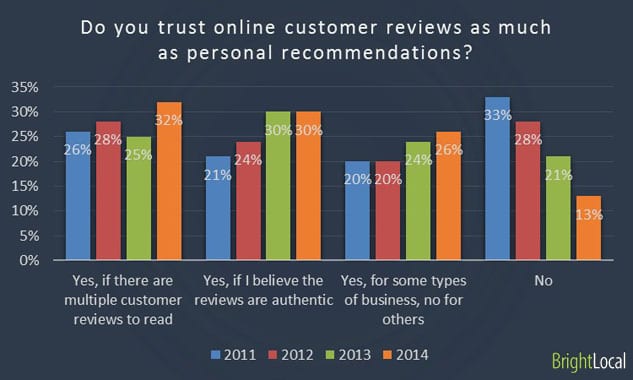
As soon as I visit the My Protein website, the first thing I am hit with is their bestsellers. Three of the four have 1,000+ reviews.

You’ll notice that the same bestsellers were in their welcome email.
Let’s be honest for a second; there are a lot of good products and services in the health and fitness niche, but there are also hundreds of bogus items that claim to make you jacked or shredded but are totally useless.
Consumers who have been buying supplements or trying various diets are aware of this, and the last thing they want to do is spend $70 on a garbage product.
And that’s why reviews in numbers are a must.
If you see a product with 100+ five-star reviews on Amazon, your brain assumes that it must be good; chances are you’ll pay more for an item with hundreds of reviews than an item with no reviews at a cheaper price.
That’s why you need reviews. The social proof will help you get more sales without having to lower your prices.
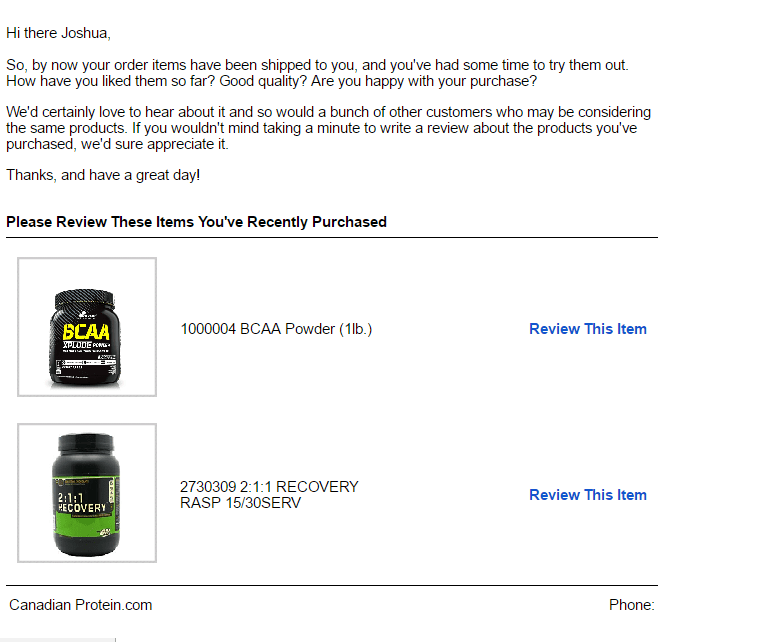
So how do you get reviews? Send an email to your customers 3-5 days after delivery asking them to leave a review on the items they just purchased, which is what Canadian Protein did.
What I like about the email is that they provide the customer with a direct link to leave a review. What I don’t like is that they offer the customer no incentive to do so, like free shipping or a discount on their next purchase.
Your customers value their time. If you would like them to help you out with a product review or any other kind of input, make it worth their while. You can do this by entering them into a sweepstake competition where they can win a free item or provide them with a token of appreciation (for example, a voucher).
To learn more, check out our guide on review request emails here.
Summary
I’ll say it again: if you’re managing a health or fitness e-commerce store, you’re going to make 80% of your revenue from repeat orders (the 80/20 rule).
Health and fitness is a lifestyle choice. Whether you sell food or supplements, your customers will need them frequently. Most business owners today focus on acquisition; they want to keep winning more new customers, but when they do they just ignore them.
Retaining your customers over a long period of time will push up your LTV and profits. The best and cheapest way to do this is through email marketing and the six types of automated email campaigns I’ve talked about above.
Facebook and Google ads have made it really hard for you to promote your products with their ad policies on what you can and cannot say. Email marketing is a cheaper and much more effective way to reach your customers.
If you have no automation process for your store so far, then if you set up each of the emails above I would not be surprised to see your average LTV rise by 20% (even more after testing).
Gainz aren’t only made in the gym and kitchen; they are also made from creating killer automated emails and working out your true LTV and CAC.

